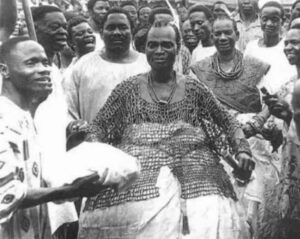The History of Ondo-Ekimogun
The History of Ondo-Ekimogun

The history of Ondo-Ekimogun traces back to the Palace of the Alaafin of Oyo, where the wife of Alaafin Oba Oluaso gave birth to twins: a boy named Orere and a girl named Olu. This was considered forbidden in the royal family. The Alaafin was so enamored with the twins’ mother, Olori Olu, that he referred to the twins as “ese-omo-re,” meaning “mysterious children,” which later influenced the title “Osemawe” in the Ondo kingdom.
After hearing of the twins, the Alaafin ordered them and their mother to leave Oyo, instructing that a single facial mark be made on each twin to protect them during their journey. This marking became a lasting tradition in Ondo. Accompanied by the leader of the Alaafin’s warriors, known as “ija,” they set out for a place called Epin.
Following the death of Alaafin Oba Oluaso in 1497, the new Alaafin, Oba Onigbogi, also exiled them in 1498. They traveled toward Ile-Ife, reaching a site called “Ita Ijama” before eventually arriving at Epe, where they were warmly welcomed by the Iyanghede of Epe. This journey contributed to their identity as “Ekimogun ara ita ijama, a fi ide agogo m’omi.”
Seeking a permanent settlement, they left Epe and reached a location now known as Ile Oluji, where Olori Olu fell into a deep sleep and did not awaken. After some time, Olori Olu and Princess Olu continued their journey, leaving Prince Orere behind. They eventually reached a hill known today as “Oke Agunla,” where they noticed smoke rising from below. Following it, they encountered a man named Ekiri, who was neither a farmer nor a hunter.
Ekiri guided them to a place called Oriden, where they attempted to plant a yam stick in the ground, as advised by an Ifa Oracle. Despite their efforts, it proved futile. In joy, they exclaimed, “Edo du do to Edo do to Idi edo,” which eventually transformed into Ondo in 1510. Princess Olu became the first Oba Pupupu of Ondo in 1516, while Prince Orere was named the first Jegun of Ile Oluji.
Historical facial marks were also established for descendants of past Osemawes from the male lineage, and both lineages share rights to the Otunba title. The Olotu Omo-Oba leads all Otunba title holders in the Oke-Otunba quarters of Ondo. The Ondo people are recognized as traders, farmers, and merchants, with a staple diet centered around yam-based dishes. They possess a distinct dialect and are known for their hard work.
Furthermore, Ondo emigrants founded various towns, including Igbado, Igbindo, Ajue, and many others. The Ondo warriors of the era were known as Ago, Taagba, and Jomu-Nla, with the title of High Chief Jomu being hereditary.
The first Osemawe palace was constructed by Oba Airo, the son of Oba Pupupu, who ascended the throne in 1530. Oba Adeuga Fidipote II built the first modern palace in 1935, while Oba Festus Ibidapo Adesanoye, known as Osungbedelola II, established the most recent palace in 1992.
The chieftaincy titles in Ondo include Iwarefa, Ekule, Elegbe, and Otu, overseen by His Highness Osemawe, while Upoji female chiefs are led by Her Highness Olobun Oba Obirin. Notable festivals celebrated in Ondo include Odun Oba, Odun Ogun, and Odun Oramfe.
In terms of religion, the Ondo people embraced Roman Catholicism in 1875 under the guidance of Rev. Bishop Phillips and later accepted the CMS Anglican Communion in 1884 and Islam in 1888. The first Ondo Rev. Father, John Akinwale, was ordained in 1947, while Rev. D.O. Awosika became the first Ondo Anglican Bishop. Alhaji Muhammed Alimi was appointed the first Imam of Ondo in 1888.
In conclusion, the Ondo people take great pride in their heritage and identity, known for their resilience and strong spirit.
TRENDING SONGS
 Ahmad Yerima: Naval Officer to Face No Sanctions After Clash with Wike – Matawalle
Ahmad Yerima: Naval Officer to Face No Sanctions After Clash with Wike – Matawalle
 Trending Video: Muslim Man Joins Wife in Hallelujah Challenge ‘Dress Like Your Miracle’ Night
Trending Video: Muslim Man Joins Wife in Hallelujah Challenge ‘Dress Like Your Miracle’ Night
 Woman Seeks Advice as Late Brother’s Wife Refuses to Mourn Him Following His Death With Alleged Mistress
Woman Seeks Advice as Late Brother’s Wife Refuses to Mourn Him Following His Death With Alleged Mistress
 Nobody Cares About Fine Girls In The UK, I Miss Nigeria — Nigerian Lady Laments
Nobody Cares About Fine Girls In The UK, I Miss Nigeria — Nigerian Lady Laments
 Wedding Called Off: How Lady Cancels Wedding After Finding Out Finance’s Affairs With Her Bestie
Wedding Called Off: How Lady Cancels Wedding After Finding Out Finance’s Affairs With Her Bestie
 Heartbreak in Ikeja: Lady Weeps After Fufu Found in New Phone Package
Heartbreak in Ikeja: Lady Weeps After Fufu Found in New Phone Package
 Twist of Fate: Man Who Questioned Phyna’s ₦1Billion Demand Mourns Brother in Dangote Truck Crash
Twist of Fate: Man Who Questioned Phyna’s ₦1Billion Demand Mourns Brother in Dangote Truck Crash
 Tragedy in Enugu: Dangote Truck Claims Lives of Family of Five
Tragedy in Enugu: Dangote Truck Claims Lives of Family of Five
 Bangkok Crackdown: Nigerian-Thai Couple in Police Net Over Drug Trafficking
Bangkok Crackdown: Nigerian-Thai Couple in Police Net Over Drug Trafficking
 Family Rift: Reno Omokri’s Ex-Wife Says He Deserted Their Special Needs Son
Family Rift: Reno Omokri’s Ex-Wife Says He Deserted Their Special Needs Son
Share this post with your friends on ![]()













